Nutrition and Diet: Food Choices, Health, and Dietary Habits Analysis
VerifiedAdded on 2020/01/23
|18
|6164
|486
Report
AI Summary
This report delves into the multifaceted world of nutrition and diet, exploring the factors that influence food choices and dietary habits, including socio-economic, cultural, and psychological aspects. It categorizes food items based on their nutritional contents, providing examples and detailing the essential nutrients like proteins, carbohydrates, fats, calcium, vitamins, iron, and fibers. The report also assesses key methods for measuring nutritional status, such as anthropometric assessment, BMI, 24-hour recall, weighted inventory, and national food surveys. Furthermore, it outlines the nutritional requirements of various groups, including children under 11, young women aged 15-18, and gardeners engaged in heavy manual labor. A tabular representation illustrates the relationship between diet and health, focusing on food commodities like cereals, milk, and oats. Finally, the report includes meal plans for specific groups like elderly and anaemic women, vegetarian teenagers, and children, alongside modifications to existing menus to implement healthy eating principles. The report is comprehensive and provides a detailed overview of the subject.
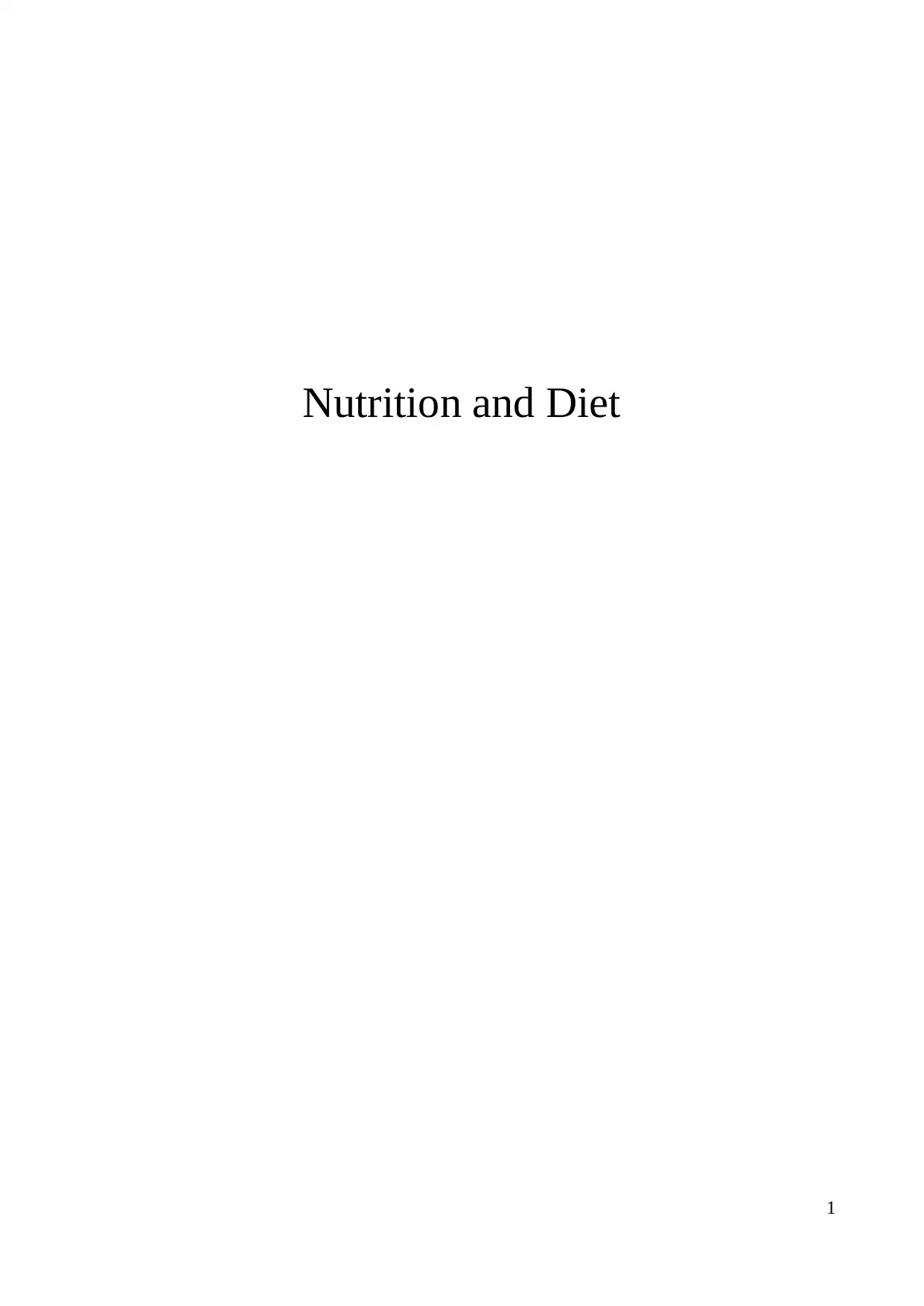
Nutrition and Diet
1
1
Paraphrase This Document
Need a fresh take? Get an instant paraphrase of this document with our AI Paraphraser
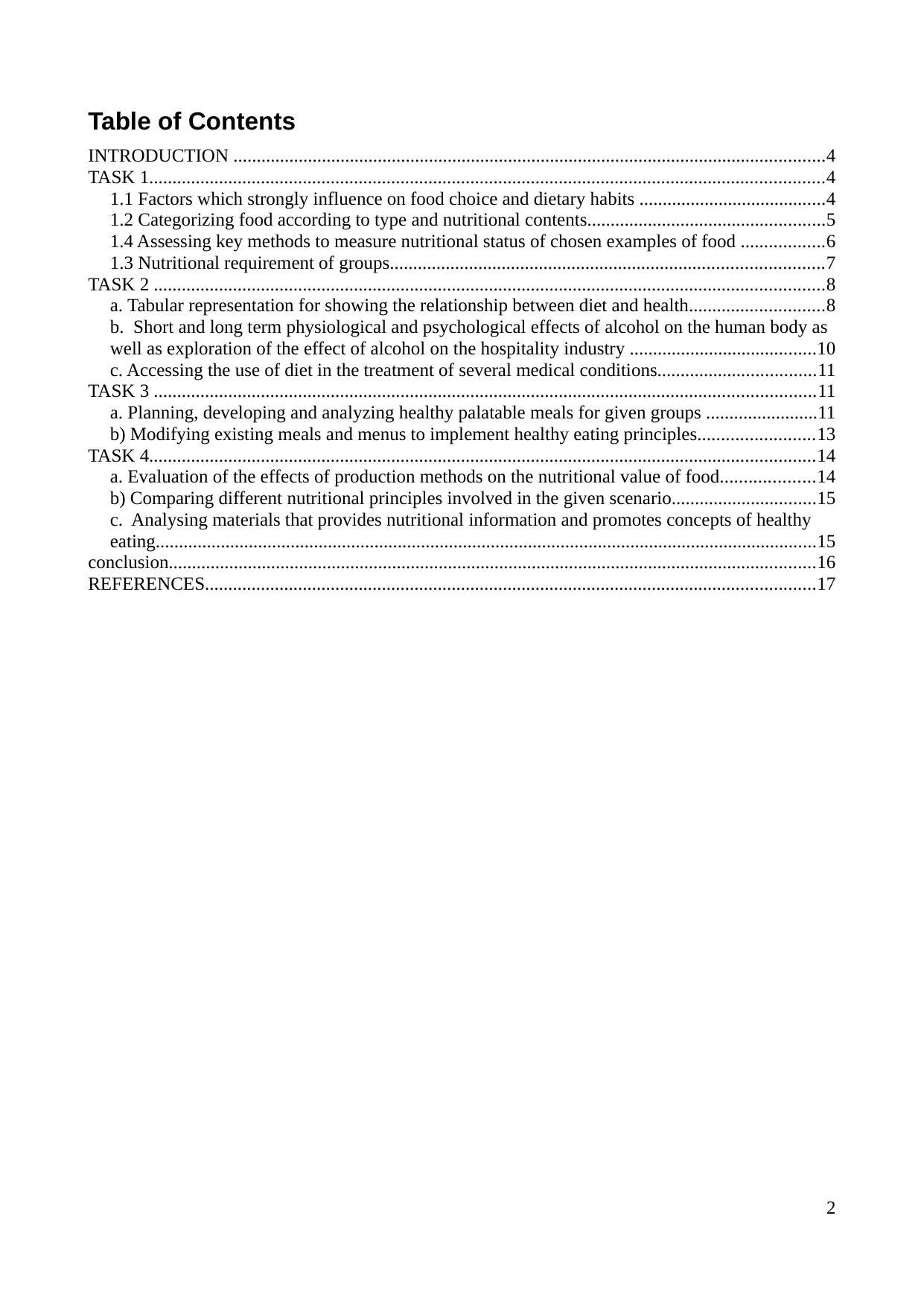
Table of Contents
INTRODUCTION ...............................................................................................................................4
TASK 1.................................................................................................................................................4
1.1 Factors which strongly influence on food choice and dietary habits ........................................4
1.2 Categorizing food according to type and nutritional contents...................................................5
1.4 Assessing key methods to measure nutritional status of chosen examples of food ..................6
1.3 Nutritional requirement of groups.............................................................................................7
TASK 2 ................................................................................................................................................8
a. Tabular representation for showing the relationship between diet and health.............................8
b. Short and long term physiological and psychological effects of alcohol on the human body as
well as exploration of the effect of alcohol on the hospitality industry ........................................10
c. Accessing the use of diet in the treatment of several medical conditions..................................11
TASK 3 ..............................................................................................................................................11
a. Planning, developing and analyzing healthy palatable meals for given groups ........................11
b) Modifying existing meals and menus to implement healthy eating principles.........................13
TASK 4...............................................................................................................................................14
a. Evaluation of the effects of production methods on the nutritional value of food....................14
b) Comparing different nutritional principles involved in the given scenario...............................15
c. Analysing materials that provides nutritional information and promotes concepts of healthy
eating..............................................................................................................................................15
conclusion...........................................................................................................................................16
REFERENCES...................................................................................................................................17
2
INTRODUCTION ...............................................................................................................................4
TASK 1.................................................................................................................................................4
1.1 Factors which strongly influence on food choice and dietary habits ........................................4
1.2 Categorizing food according to type and nutritional contents...................................................5
1.4 Assessing key methods to measure nutritional status of chosen examples of food ..................6
1.3 Nutritional requirement of groups.............................................................................................7
TASK 2 ................................................................................................................................................8
a. Tabular representation for showing the relationship between diet and health.............................8
b. Short and long term physiological and psychological effects of alcohol on the human body as
well as exploration of the effect of alcohol on the hospitality industry ........................................10
c. Accessing the use of diet in the treatment of several medical conditions..................................11
TASK 3 ..............................................................................................................................................11
a. Planning, developing and analyzing healthy palatable meals for given groups ........................11
b) Modifying existing meals and menus to implement healthy eating principles.........................13
TASK 4...............................................................................................................................................14
a. Evaluation of the effects of production methods on the nutritional value of food....................14
b) Comparing different nutritional principles involved in the given scenario...............................15
c. Analysing materials that provides nutritional information and promotes concepts of healthy
eating..............................................................................................................................................15
conclusion...........................................................................................................................................16
REFERENCES...................................................................................................................................17
2
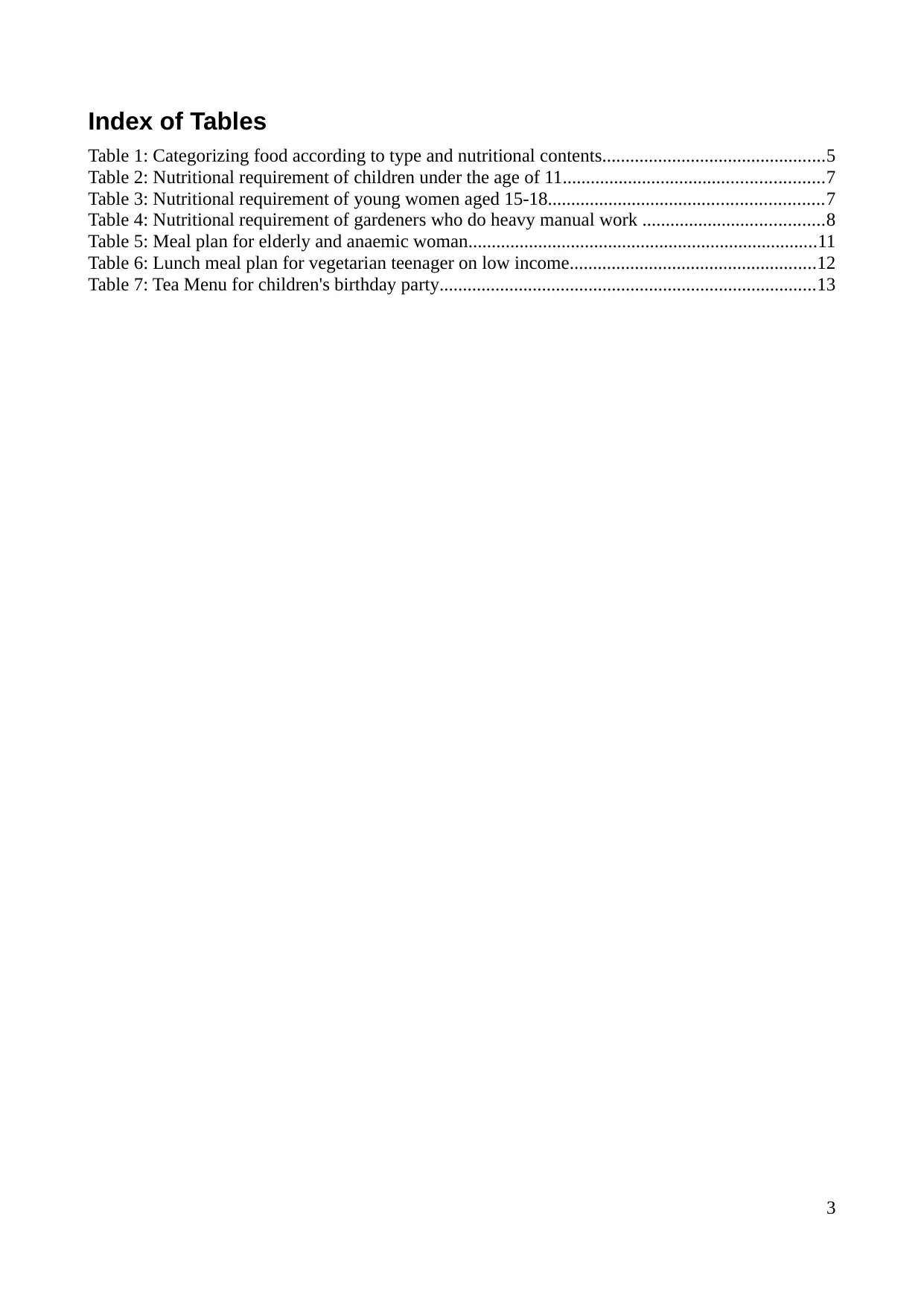
Index of Tables
Table 1: Categorizing food according to type and nutritional contents................................................5
Table 2: Nutritional requirement of children under the age of 11........................................................7
Table 3: Nutritional requirement of young women aged 15-18...........................................................7
Table 4: Nutritional requirement of gardeners who do heavy manual work .......................................8
Table 5: Meal plan for elderly and anaemic woman...........................................................................11
Table 6: Lunch meal plan for vegetarian teenager on low income.....................................................12
Table 7: Tea Menu for children's birthday party.................................................................................13
3
Table 1: Categorizing food according to type and nutritional contents................................................5
Table 2: Nutritional requirement of children under the age of 11........................................................7
Table 3: Nutritional requirement of young women aged 15-18...........................................................7
Table 4: Nutritional requirement of gardeners who do heavy manual work .......................................8
Table 5: Meal plan for elderly and anaemic woman...........................................................................11
Table 6: Lunch meal plan for vegetarian teenager on low income.....................................................12
Table 7: Tea Menu for children's birthday party.................................................................................13
3
⊘ This is a preview!⊘
Do you want full access?
Subscribe today to unlock all pages.

Trusted by 1+ million students worldwide
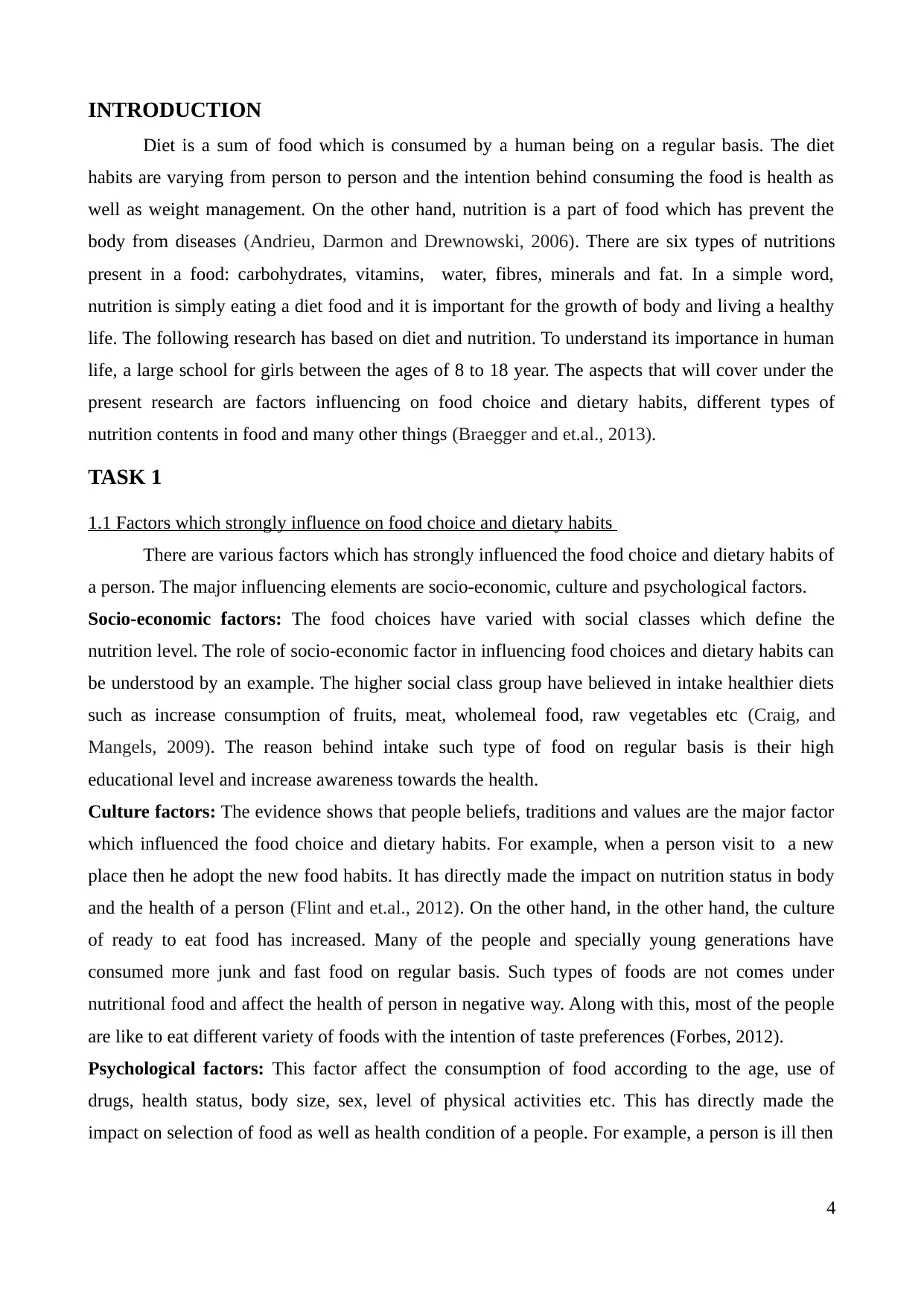
INTRODUCTION
Diet is a sum of food which is consumed by a human being on a regular basis. The diet
habits are varying from person to person and the intention behind consuming the food is health as
well as weight management. On the other hand, nutrition is a part of food which has prevent the
body from diseases (Andrieu, Darmon and Drewnowski, 2006). There are six types of nutritions
present in a food: carbohydrates, vitamins, water, fibres, minerals and fat. In a simple word,
nutrition is simply eating a diet food and it is important for the growth of body and living a healthy
life. The following research has based on diet and nutrition. To understand its importance in human
life, a large school for girls between the ages of 8 to 18 year. The aspects that will cover under the
present research are factors influencing on food choice and dietary habits, different types of
nutrition contents in food and many other things (Braegger and et.al., 2013).
TASK 1
1.1 Factors which strongly influence on food choice and dietary habits
There are various factors which has strongly influenced the food choice and dietary habits of
a person. The major influencing elements are socio-economic, culture and psychological factors.
Socio-economic factors: The food choices have varied with social classes which define the
nutrition level. The role of socio-economic factor in influencing food choices and dietary habits can
be understood by an example. The higher social class group have believed in intake healthier diets
such as increase consumption of fruits, meat, wholemeal food, raw vegetables etc (Craig, and
Mangels, 2009). The reason behind intake such type of food on regular basis is their high
educational level and increase awareness towards the health.
Culture factors: The evidence shows that people beliefs, traditions and values are the major factor
which influenced the food choice and dietary habits. For example, when a person visit to a new
place then he adopt the new food habits. It has directly made the impact on nutrition status in body
and the health of a person (Flint and et.al., 2012). On the other hand, in the other hand, the culture
of ready to eat food has increased. Many of the people and specially young generations have
consumed more junk and fast food on regular basis. Such types of foods are not comes under
nutritional food and affect the health of person in negative way. Along with this, most of the people
are like to eat different variety of foods with the intention of taste preferences (Forbes, 2012).
Psychological factors: This factor affect the consumption of food according to the age, use of
drugs, health status, body size, sex, level of physical activities etc. This has directly made the
impact on selection of food as well as health condition of a people. For example, a person is ill then
4
Diet is a sum of food which is consumed by a human being on a regular basis. The diet
habits are varying from person to person and the intention behind consuming the food is health as
well as weight management. On the other hand, nutrition is a part of food which has prevent the
body from diseases (Andrieu, Darmon and Drewnowski, 2006). There are six types of nutritions
present in a food: carbohydrates, vitamins, water, fibres, minerals and fat. In a simple word,
nutrition is simply eating a diet food and it is important for the growth of body and living a healthy
life. The following research has based on diet and nutrition. To understand its importance in human
life, a large school for girls between the ages of 8 to 18 year. The aspects that will cover under the
present research are factors influencing on food choice and dietary habits, different types of
nutrition contents in food and many other things (Braegger and et.al., 2013).
TASK 1
1.1 Factors which strongly influence on food choice and dietary habits
There are various factors which has strongly influenced the food choice and dietary habits of
a person. The major influencing elements are socio-economic, culture and psychological factors.
Socio-economic factors: The food choices have varied with social classes which define the
nutrition level. The role of socio-economic factor in influencing food choices and dietary habits can
be understood by an example. The higher social class group have believed in intake healthier diets
such as increase consumption of fruits, meat, wholemeal food, raw vegetables etc (Craig, and
Mangels, 2009). The reason behind intake such type of food on regular basis is their high
educational level and increase awareness towards the health.
Culture factors: The evidence shows that people beliefs, traditions and values are the major factor
which influenced the food choice and dietary habits. For example, when a person visit to a new
place then he adopt the new food habits. It has directly made the impact on nutrition status in body
and the health of a person (Flint and et.al., 2012). On the other hand, in the other hand, the culture
of ready to eat food has increased. Many of the people and specially young generations have
consumed more junk and fast food on regular basis. Such types of foods are not comes under
nutritional food and affect the health of person in negative way. Along with this, most of the people
are like to eat different variety of foods with the intention of taste preferences (Forbes, 2012).
Psychological factors: This factor affect the consumption of food according to the age, use of
drugs, health status, body size, sex, level of physical activities etc. This has directly made the
impact on selection of food as well as health condition of a people. For example, a person is ill then
4
Paraphrase This Document
Need a fresh take? Get an instant paraphrase of this document with our AI Paraphraser
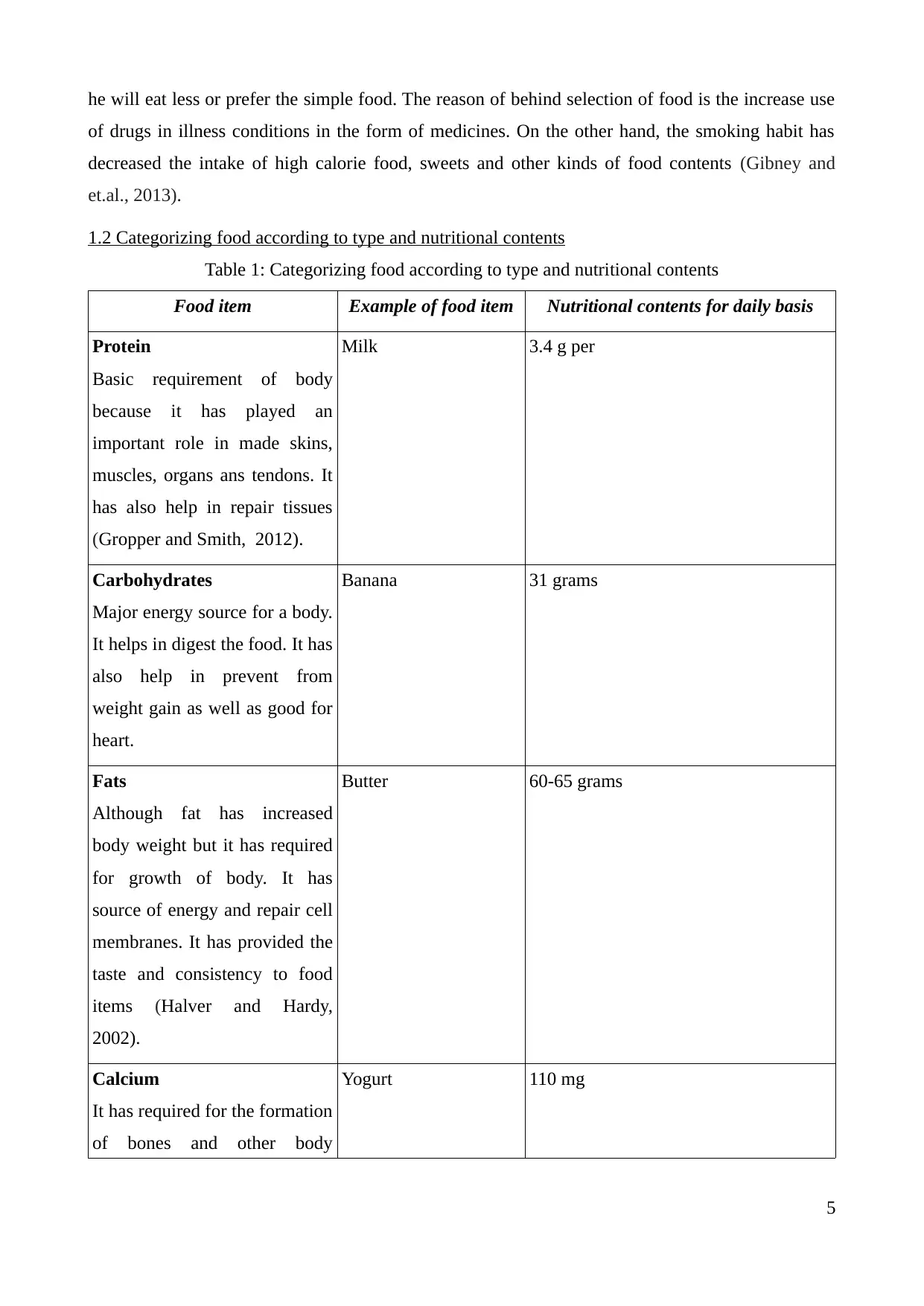
he will eat less or prefer the simple food. The reason of behind selection of food is the increase use
of drugs in illness conditions in the form of medicines. On the other hand, the smoking habit has
decreased the intake of high calorie food, sweets and other kinds of food contents (Gibney and
et.al., 2013).
1.2 Categorizing food according to type and nutritional contents
Table 1: Categorizing food according to type and nutritional contents
Food item Example of food item Nutritional contents for daily basis
Protein
Basic requirement of body
because it has played an
important role in made skins,
muscles, organs ans tendons. It
has also help in repair tissues
(Gropper and Smith, 2012).
Milk 3.4 g per
Carbohydrates
Major energy source for a body.
It helps in digest the food. It has
also help in prevent from
weight gain as well as good for
heart.
Banana 31 grams
Fats
Although fat has increased
body weight but it has required
for growth of body. It has
source of energy and repair cell
membranes. It has provided the
taste and consistency to food
items (Halver and Hardy,
2002).
Butter 60-65 grams
Calcium
It has required for the formation
of bones and other body
Yogurt 110 mg
5
of drugs in illness conditions in the form of medicines. On the other hand, the smoking habit has
decreased the intake of high calorie food, sweets and other kinds of food contents (Gibney and
et.al., 2013).
1.2 Categorizing food according to type and nutritional contents
Table 1: Categorizing food according to type and nutritional contents
Food item Example of food item Nutritional contents for daily basis
Protein
Basic requirement of body
because it has played an
important role in made skins,
muscles, organs ans tendons. It
has also help in repair tissues
(Gropper and Smith, 2012).
Milk 3.4 g per
Carbohydrates
Major energy source for a body.
It helps in digest the food. It has
also help in prevent from
weight gain as well as good for
heart.
Banana 31 grams
Fats
Although fat has increased
body weight but it has required
for growth of body. It has
source of energy and repair cell
membranes. It has provided the
taste and consistency to food
items (Halver and Hardy,
2002).
Butter 60-65 grams
Calcium
It has required for the formation
of bones and other body
Yogurt 110 mg
5
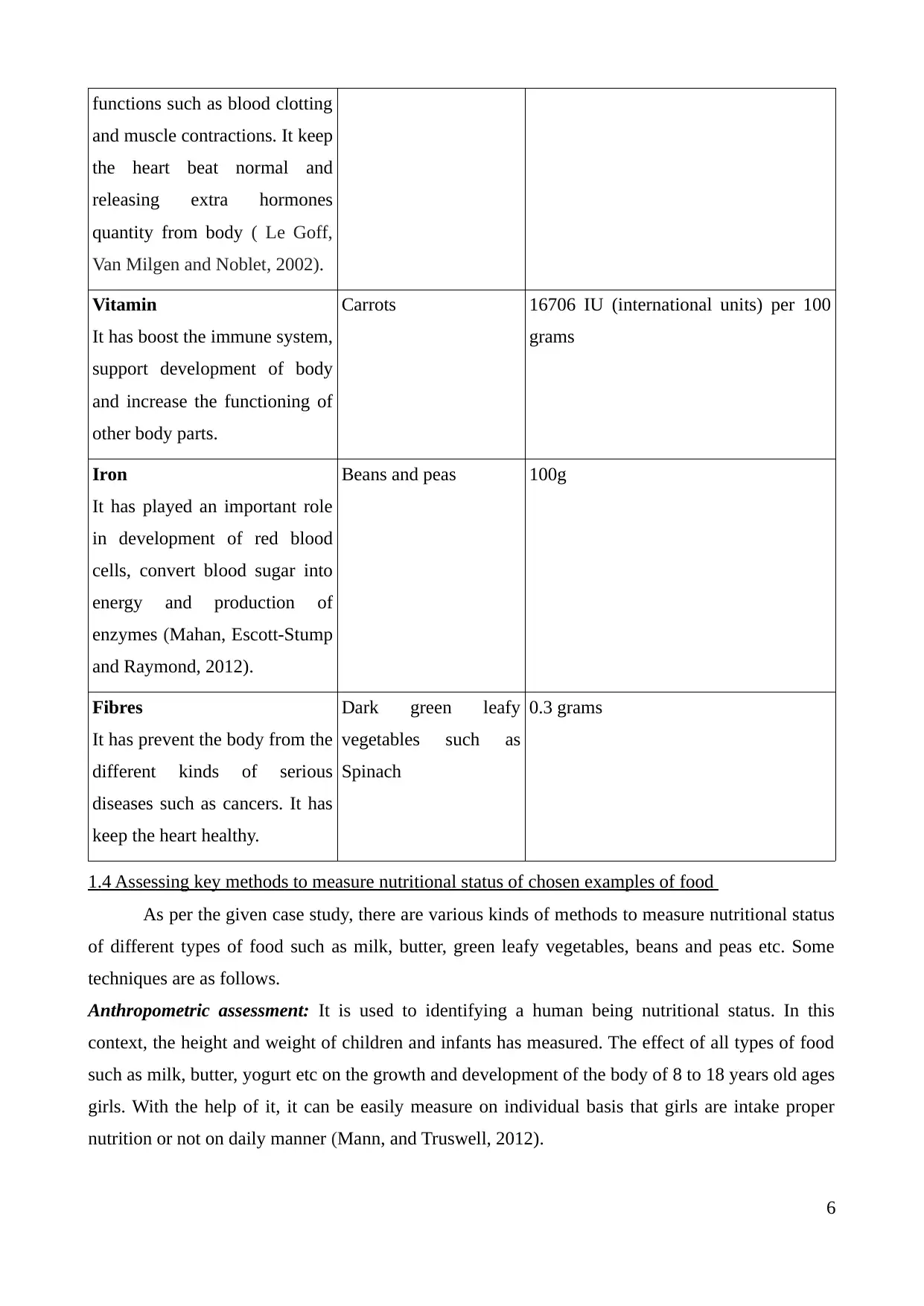
functions such as blood clotting
and muscle contractions. It keep
the heart beat normal and
releasing extra hormones
quantity from body ( Le Goff,
Van Milgen and Noblet, 2002).
Vitamin
It has boost the immune system,
support development of body
and increase the functioning of
other body parts.
Carrots 16706 IU (international units) per 100
grams
Iron
It has played an important role
in development of red blood
cells, convert blood sugar into
energy and production of
enzymes (Mahan, Escott-Stump
and Raymond, 2012).
Beans and peas 100g
Fibres
It has prevent the body from the
different kinds of serious
diseases such as cancers. It has
keep the heart healthy.
Dark green leafy
vegetables such as
Spinach
0.3 grams
1.4 Assessing key methods to measure nutritional status of chosen examples of food
As per the given case study, there are various kinds of methods to measure nutritional status
of different types of food such as milk, butter, green leafy vegetables, beans and peas etc. Some
techniques are as follows.
Anthropometric assessment: It is used to identifying a human being nutritional status. In this
context, the height and weight of children and infants has measured. The effect of all types of food
such as milk, butter, yogurt etc on the growth and development of the body of 8 to 18 years old ages
girls. With the help of it, it can be easily measure on individual basis that girls are intake proper
nutrition or not on daily manner (Mann, and Truswell, 2012).
6
and muscle contractions. It keep
the heart beat normal and
releasing extra hormones
quantity from body ( Le Goff,
Van Milgen and Noblet, 2002).
Vitamin
It has boost the immune system,
support development of body
and increase the functioning of
other body parts.
Carrots 16706 IU (international units) per 100
grams
Iron
It has played an important role
in development of red blood
cells, convert blood sugar into
energy and production of
enzymes (Mahan, Escott-Stump
and Raymond, 2012).
Beans and peas 100g
Fibres
It has prevent the body from the
different kinds of serious
diseases such as cancers. It has
keep the heart healthy.
Dark green leafy
vegetables such as
Spinach
0.3 grams
1.4 Assessing key methods to measure nutritional status of chosen examples of food
As per the given case study, there are various kinds of methods to measure nutritional status
of different types of food such as milk, butter, green leafy vegetables, beans and peas etc. Some
techniques are as follows.
Anthropometric assessment: It is used to identifying a human being nutritional status. In this
context, the height and weight of children and infants has measured. The effect of all types of food
such as milk, butter, yogurt etc on the growth and development of the body of 8 to 18 years old ages
girls. With the help of it, it can be easily measure on individual basis that girls are intake proper
nutrition or not on daily manner (Mann, and Truswell, 2012).
6
⊘ This is a preview!⊘
Do you want full access?
Subscribe today to unlock all pages.

Trusted by 1+ million students worldwide
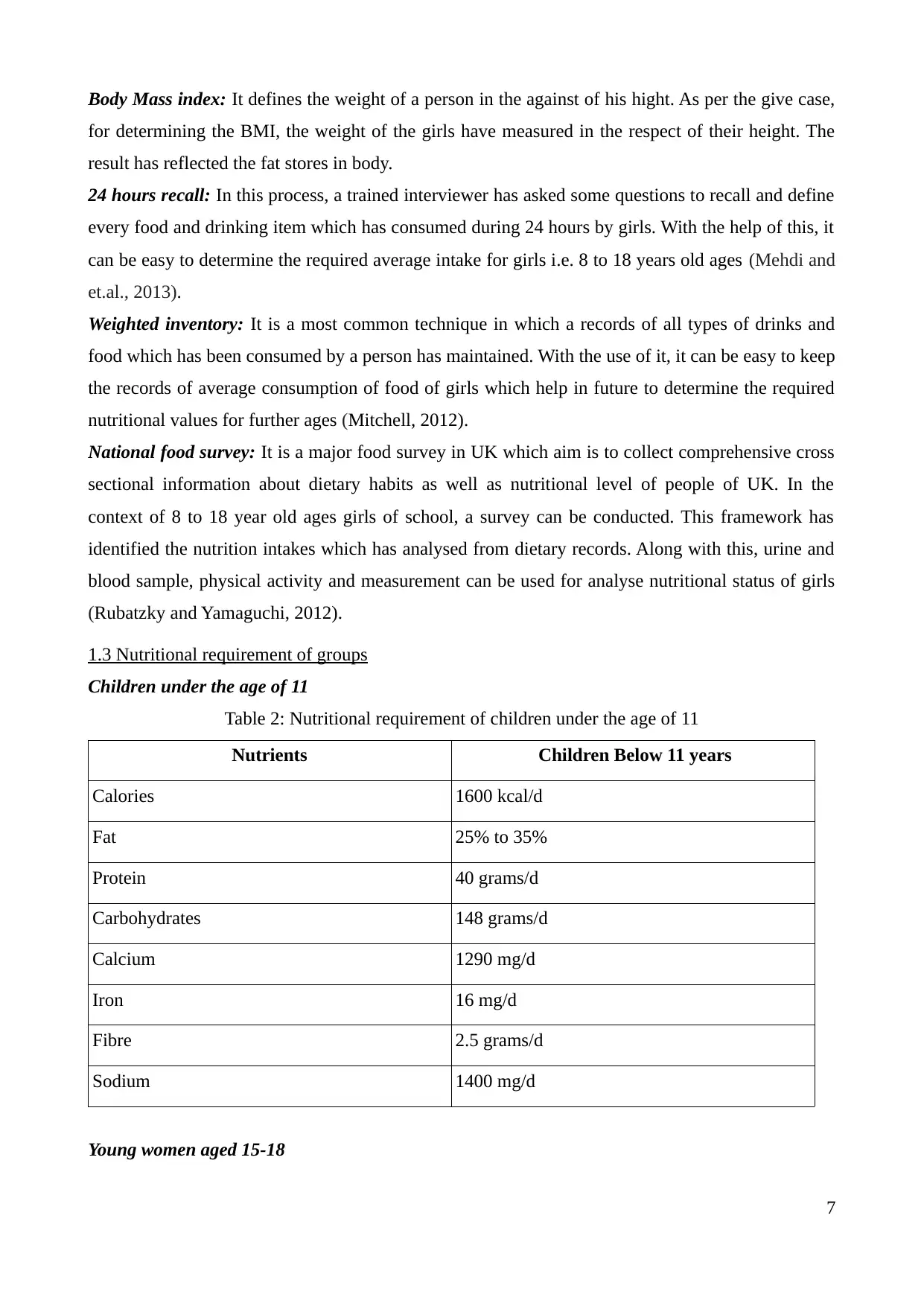
Body Mass index: It defines the weight of a person in the against of his hight. As per the give case,
for determining the BMI, the weight of the girls have measured in the respect of their height. The
result has reflected the fat stores in body.
24 hours recall: In this process, a trained interviewer has asked some questions to recall and define
every food and drinking item which has consumed during 24 hours by girls. With the help of this, it
can be easy to determine the required average intake for girls i.e. 8 to 18 years old ages (Mehdi and
et.al., 2013).
Weighted inventory: It is a most common technique in which a records of all types of drinks and
food which has been consumed by a person has maintained. With the use of it, it can be easy to keep
the records of average consumption of food of girls which help in future to determine the required
nutritional values for further ages (Mitchell, 2012).
National food survey: It is a major food survey in UK which aim is to collect comprehensive cross
sectional information about dietary habits as well as nutritional level of people of UK. In the
context of 8 to 18 year old ages girls of school, a survey can be conducted. This framework has
identified the nutrition intakes which has analysed from dietary records. Along with this, urine and
blood sample, physical activity and measurement can be used for analyse nutritional status of girls
(Rubatzky and Yamaguchi, 2012).
1.3 Nutritional requirement of groups
Children under the age of 11
Table 2: Nutritional requirement of children under the age of 11
Nutrients Children Below 11 years
Calories 1600 kcal/d
Fat 25% to 35%
Protein 40 grams/d
Carbohydrates 148 grams/d
Calcium 1290 mg/d
Iron 16 mg/d
Fibre 2.5 grams/d
Sodium 1400 mg/d
Young women aged 15-18
7
for determining the BMI, the weight of the girls have measured in the respect of their height. The
result has reflected the fat stores in body.
24 hours recall: In this process, a trained interviewer has asked some questions to recall and define
every food and drinking item which has consumed during 24 hours by girls. With the help of this, it
can be easy to determine the required average intake for girls i.e. 8 to 18 years old ages (Mehdi and
et.al., 2013).
Weighted inventory: It is a most common technique in which a records of all types of drinks and
food which has been consumed by a person has maintained. With the use of it, it can be easy to keep
the records of average consumption of food of girls which help in future to determine the required
nutritional values for further ages (Mitchell, 2012).
National food survey: It is a major food survey in UK which aim is to collect comprehensive cross
sectional information about dietary habits as well as nutritional level of people of UK. In the
context of 8 to 18 year old ages girls of school, a survey can be conducted. This framework has
identified the nutrition intakes which has analysed from dietary records. Along with this, urine and
blood sample, physical activity and measurement can be used for analyse nutritional status of girls
(Rubatzky and Yamaguchi, 2012).
1.3 Nutritional requirement of groups
Children under the age of 11
Table 2: Nutritional requirement of children under the age of 11
Nutrients Children Below 11 years
Calories 1600 kcal/d
Fat 25% to 35%
Protein 40 grams/d
Carbohydrates 148 grams/d
Calcium 1290 mg/d
Iron 16 mg/d
Fibre 2.5 grams/d
Sodium 1400 mg/d
Young women aged 15-18
7
Paraphrase This Document
Need a fresh take? Get an instant paraphrase of this document with our AI Paraphraser
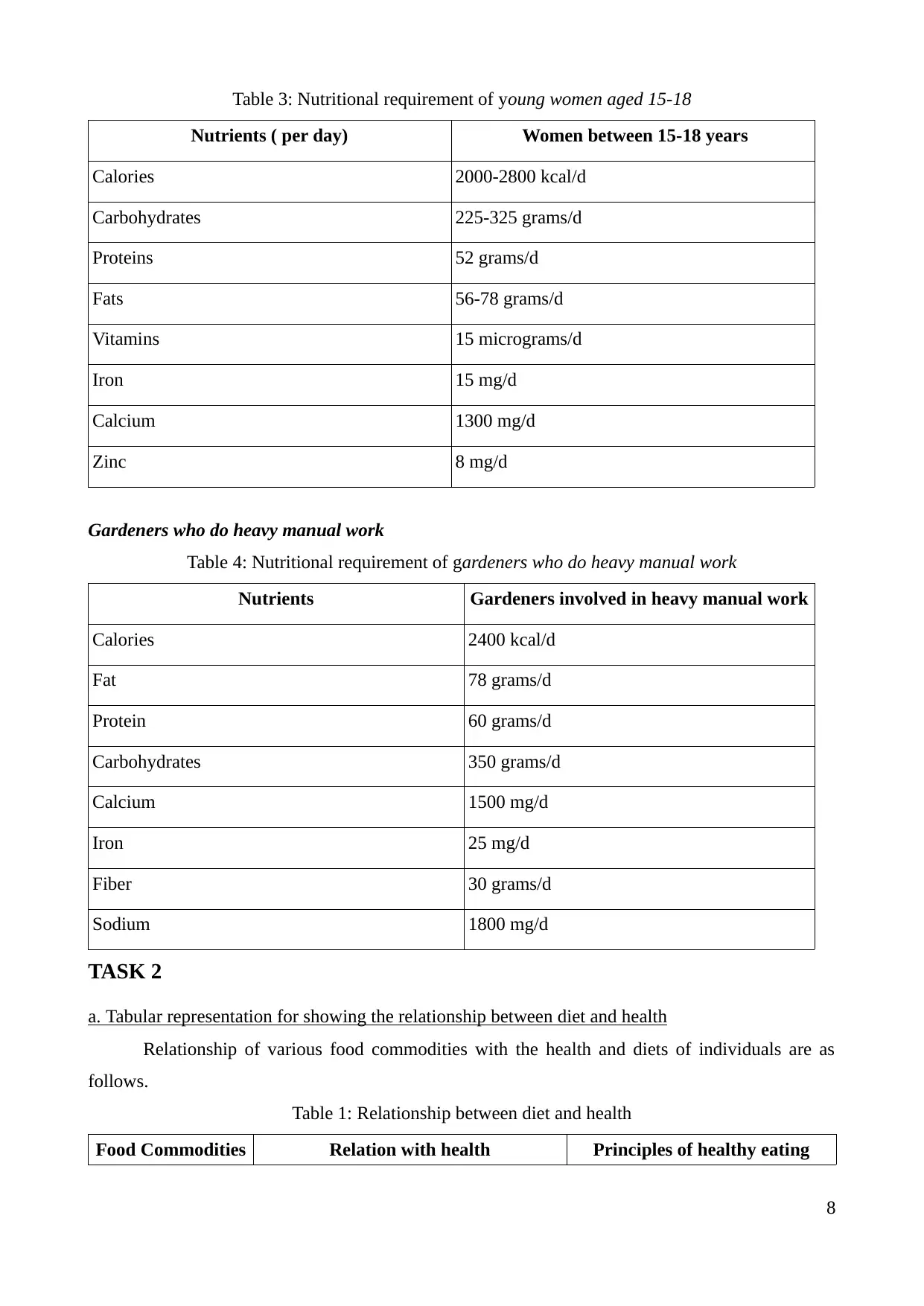
Table 3: Nutritional requirement of young women aged 15-18
Nutrients ( per day) Women between 15-18 years
Calories 2000-2800 kcal/d
Carbohydrates 225-325 grams/d
Proteins 52 grams/d
Fats 56-78 grams/d
Vitamins 15 micrograms/d
Iron 15 mg/d
Calcium 1300 mg/d
Zinc 8 mg/d
Gardeners who do heavy manual work
Table 4: Nutritional requirement of gardeners who do heavy manual work
Nutrients Gardeners involved in heavy manual work
Calories 2400 kcal/d
Fat 78 grams/d
Protein 60 grams/d
Carbohydrates 350 grams/d
Calcium 1500 mg/d
Iron 25 mg/d
Fiber 30 grams/d
Sodium 1800 mg/d
TASK 2
a. Tabular representation for showing the relationship between diet and health
Relationship of various food commodities with the health and diets of individuals are as
follows.
Table 1: Relationship between diet and health
Food Commodities Relation with health Principles of healthy eating
8
Nutrients ( per day) Women between 15-18 years
Calories 2000-2800 kcal/d
Carbohydrates 225-325 grams/d
Proteins 52 grams/d
Fats 56-78 grams/d
Vitamins 15 micrograms/d
Iron 15 mg/d
Calcium 1300 mg/d
Zinc 8 mg/d
Gardeners who do heavy manual work
Table 4: Nutritional requirement of gardeners who do heavy manual work
Nutrients Gardeners involved in heavy manual work
Calories 2400 kcal/d
Fat 78 grams/d
Protein 60 grams/d
Carbohydrates 350 grams/d
Calcium 1500 mg/d
Iron 25 mg/d
Fiber 30 grams/d
Sodium 1800 mg/d
TASK 2
a. Tabular representation for showing the relationship between diet and health
Relationship of various food commodities with the health and diets of individuals are as
follows.
Table 1: Relationship between diet and health
Food Commodities Relation with health Principles of healthy eating
8
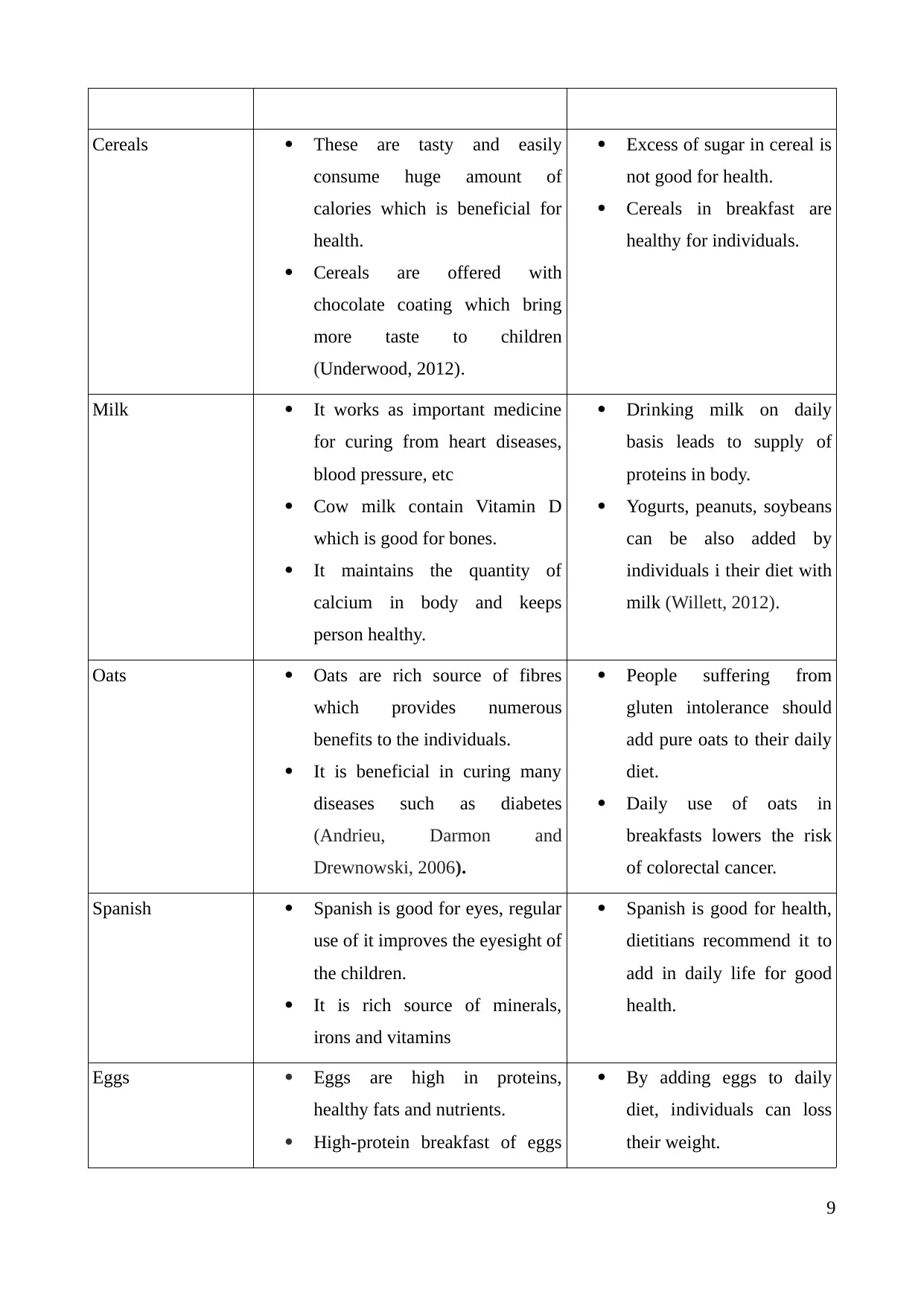
Cereals These are tasty and easily
consume huge amount of
calories which is beneficial for
health.
Cereals are offered with
chocolate coating which bring
more taste to children
(Underwood, 2012).
Excess of sugar in cereal is
not good for health.
Cereals in breakfast are
healthy for individuals.
Milk It works as important medicine
for curing from heart diseases,
blood pressure, etc
Cow milk contain Vitamin D
which is good for bones.
It maintains the quantity of
calcium in body and keeps
person healthy.
Drinking milk on daily
basis leads to supply of
proteins in body.
Yogurts, peanuts, soybeans
can be also added by
individuals i their diet with
milk (Willett, 2012).
Oats Oats are rich source of fibres
which provides numerous
benefits to the individuals.
It is beneficial in curing many
diseases such as diabetes
(Andrieu, Darmon and
Drewnowski, 2006).
People suffering from
gluten intolerance should
add pure oats to their daily
diet.
Daily use of oats in
breakfasts lowers the risk
of colorectal cancer.
Spanish Spanish is good for eyes, regular
use of it improves the eyesight of
the children.
It is rich source of minerals,
irons and vitamins
Spanish is good for health,
dietitians recommend it to
add in daily life for good
health.
Eggs Eggs are high in proteins,
healthy fats and nutrients.
High-protein breakfast of eggs
By adding eggs to daily
diet, individuals can loss
their weight.
9
consume huge amount of
calories which is beneficial for
health.
Cereals are offered with
chocolate coating which bring
more taste to children
(Underwood, 2012).
Excess of sugar in cereal is
not good for health.
Cereals in breakfast are
healthy for individuals.
Milk It works as important medicine
for curing from heart diseases,
blood pressure, etc
Cow milk contain Vitamin D
which is good for bones.
It maintains the quantity of
calcium in body and keeps
person healthy.
Drinking milk on daily
basis leads to supply of
proteins in body.
Yogurts, peanuts, soybeans
can be also added by
individuals i their diet with
milk (Willett, 2012).
Oats Oats are rich source of fibres
which provides numerous
benefits to the individuals.
It is beneficial in curing many
diseases such as diabetes
(Andrieu, Darmon and
Drewnowski, 2006).
People suffering from
gluten intolerance should
add pure oats to their daily
diet.
Daily use of oats in
breakfasts lowers the risk
of colorectal cancer.
Spanish Spanish is good for eyes, regular
use of it improves the eyesight of
the children.
It is rich source of minerals,
irons and vitamins
Spanish is good for health,
dietitians recommend it to
add in daily life for good
health.
Eggs Eggs are high in proteins,
healthy fats and nutrients.
High-protein breakfast of eggs
By adding eggs to daily
diet, individuals can loss
their weight.
9
⊘ This is a preview!⊘
Do you want full access?
Subscribe today to unlock all pages.

Trusted by 1+ million students worldwide
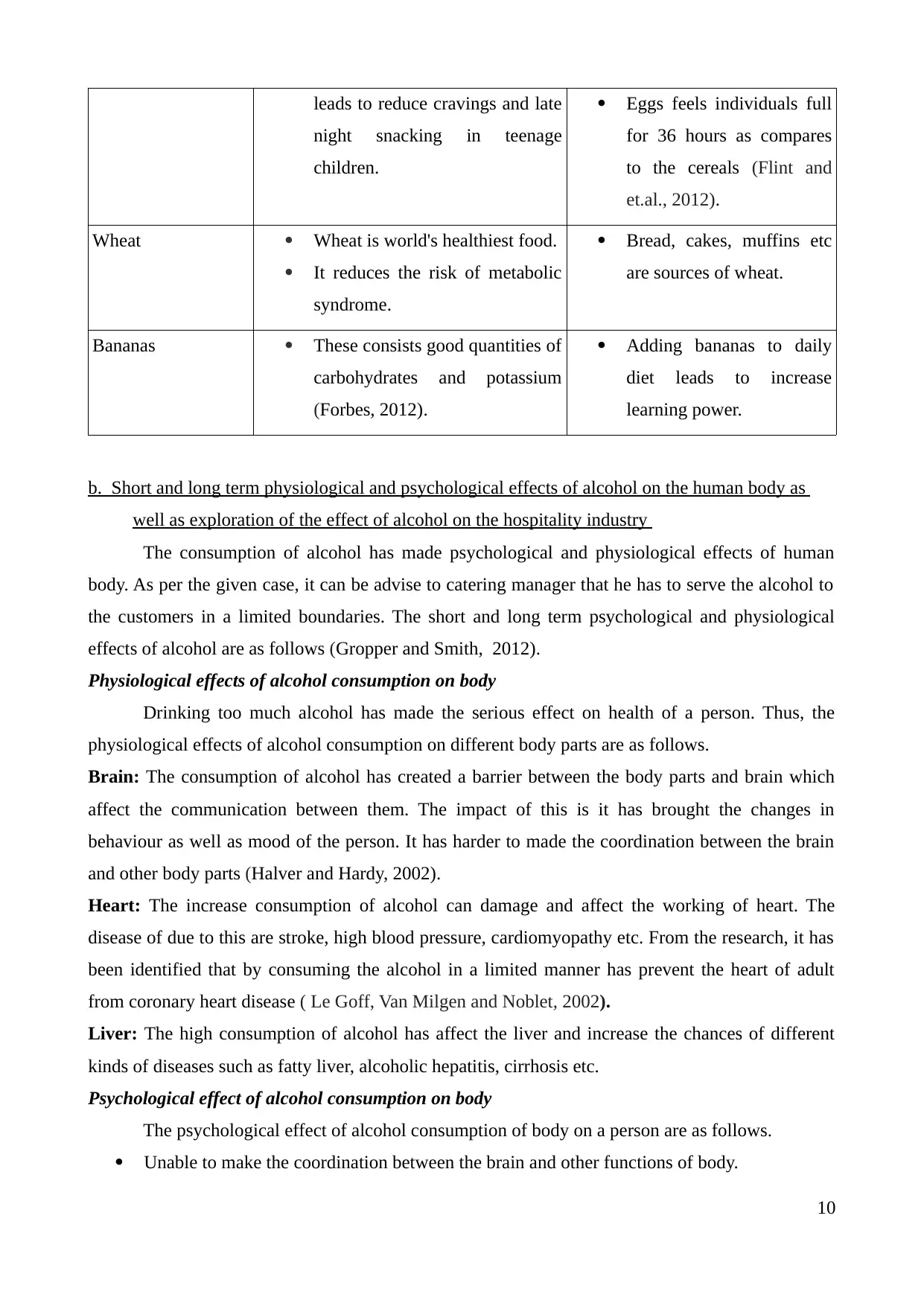
leads to reduce cravings and late
night snacking in teenage
children.
Eggs feels individuals full
for 36 hours as compares
to the cereals (Flint and
et.al., 2012).
Wheat Wheat is world's healthiest food.
It reduces the risk of metabolic
syndrome.
Bread, cakes, muffins etc
are sources of wheat.
Bananas These consists good quantities of
carbohydrates and potassium
(Forbes, 2012).
Adding bananas to daily
diet leads to increase
learning power.
b. Short and long term physiological and psychological effects of alcohol on the human body as
well as exploration of the effect of alcohol on the hospitality industry
The consumption of alcohol has made psychological and physiological effects of human
body. As per the given case, it can be advise to catering manager that he has to serve the alcohol to
the customers in a limited boundaries. The short and long term psychological and physiological
effects of alcohol are as follows (Gropper and Smith, 2012).
Physiological effects of alcohol consumption on body
Drinking too much alcohol has made the serious effect on health of a person. Thus, the
physiological effects of alcohol consumption on different body parts are as follows.
Brain: The consumption of alcohol has created a barrier between the body parts and brain which
affect the communication between them. The impact of this is it has brought the changes in
behaviour as well as mood of the person. It has harder to made the coordination between the brain
and other body parts (Halver and Hardy, 2002).
Heart: The increase consumption of alcohol can damage and affect the working of heart. The
disease of due to this are stroke, high blood pressure, cardiomyopathy etc. From the research, it has
been identified that by consuming the alcohol in a limited manner has prevent the heart of adult
from coronary heart disease ( Le Goff, Van Milgen and Noblet, 2002).
Liver: The high consumption of alcohol has affect the liver and increase the chances of different
kinds of diseases such as fatty liver, alcoholic hepatitis, cirrhosis etc.
Psychological effect of alcohol consumption on body
The psychological effect of alcohol consumption of body on a person are as follows.
Unable to make the coordination between the brain and other functions of body.
10
night snacking in teenage
children.
Eggs feels individuals full
for 36 hours as compares
to the cereals (Flint and
et.al., 2012).
Wheat Wheat is world's healthiest food.
It reduces the risk of metabolic
syndrome.
Bread, cakes, muffins etc
are sources of wheat.
Bananas These consists good quantities of
carbohydrates and potassium
(Forbes, 2012).
Adding bananas to daily
diet leads to increase
learning power.
b. Short and long term physiological and psychological effects of alcohol on the human body as
well as exploration of the effect of alcohol on the hospitality industry
The consumption of alcohol has made psychological and physiological effects of human
body. As per the given case, it can be advise to catering manager that he has to serve the alcohol to
the customers in a limited boundaries. The short and long term psychological and physiological
effects of alcohol are as follows (Gropper and Smith, 2012).
Physiological effects of alcohol consumption on body
Drinking too much alcohol has made the serious effect on health of a person. Thus, the
physiological effects of alcohol consumption on different body parts are as follows.
Brain: The consumption of alcohol has created a barrier between the body parts and brain which
affect the communication between them. The impact of this is it has brought the changes in
behaviour as well as mood of the person. It has harder to made the coordination between the brain
and other body parts (Halver and Hardy, 2002).
Heart: The increase consumption of alcohol can damage and affect the working of heart. The
disease of due to this are stroke, high blood pressure, cardiomyopathy etc. From the research, it has
been identified that by consuming the alcohol in a limited manner has prevent the heart of adult
from coronary heart disease ( Le Goff, Van Milgen and Noblet, 2002).
Liver: The high consumption of alcohol has affect the liver and increase the chances of different
kinds of diseases such as fatty liver, alcoholic hepatitis, cirrhosis etc.
Psychological effect of alcohol consumption on body
The psychological effect of alcohol consumption of body on a person are as follows.
Unable to make the coordination between the brain and other functions of body.
10
Paraphrase This Document
Need a fresh take? Get an instant paraphrase of this document with our AI Paraphraser
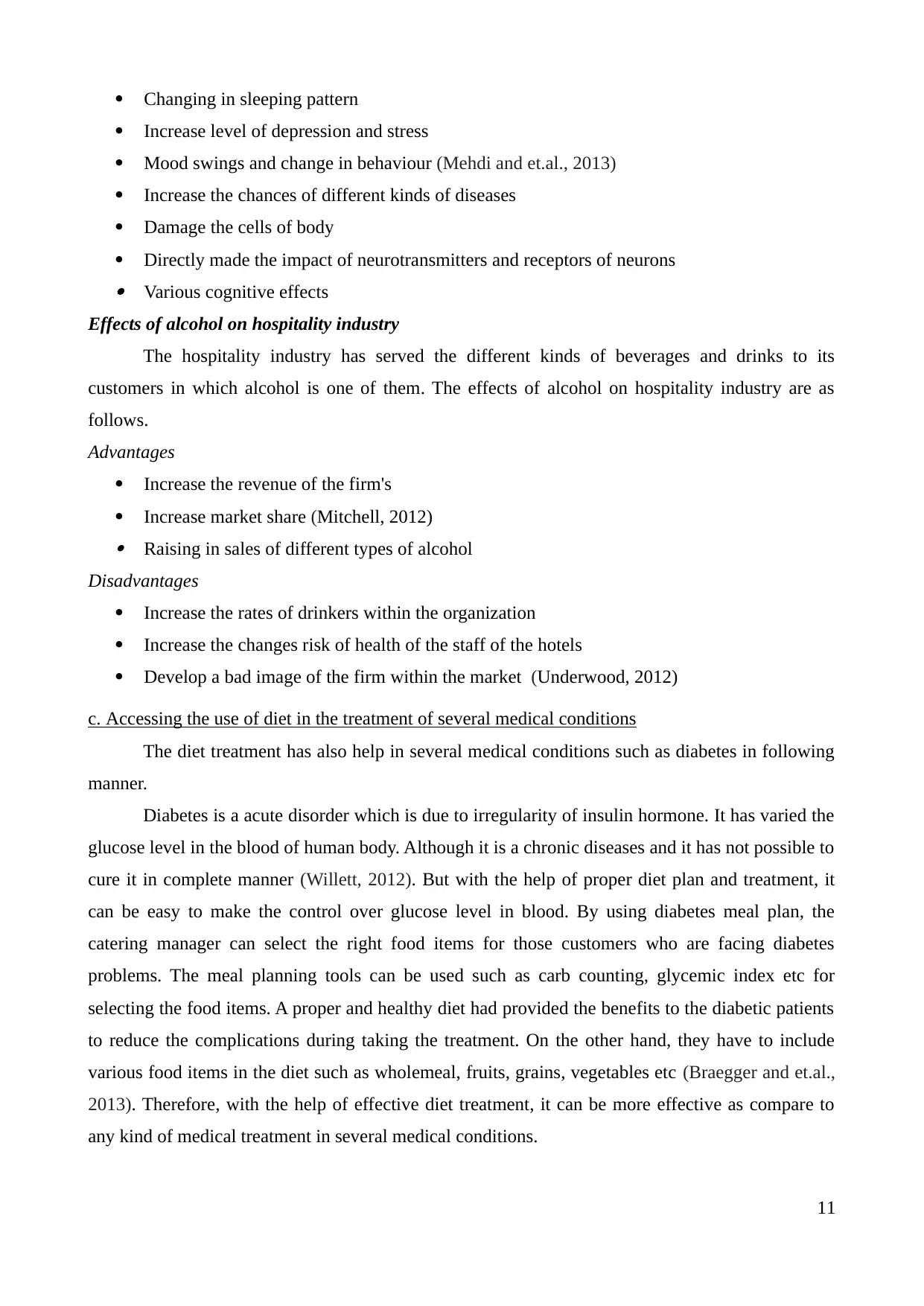
Changing in sleeping pattern
Increase level of depression and stress
Mood swings and change in behaviour (Mehdi and et.al., 2013)
Increase the chances of different kinds of diseases
Damage the cells of body
Directly made the impact of neurotransmitters and receptors of neurons Various cognitive effects
Effects of alcohol on hospitality industry
The hospitality industry has served the different kinds of beverages and drinks to its
customers in which alcohol is one of them. The effects of alcohol on hospitality industry are as
follows.
Advantages
Increase the revenue of the firm's
Increase market share (Mitchell, 2012) Raising in sales of different types of alcohol
Disadvantages
Increase the rates of drinkers within the organization
Increase the changes risk of health of the staff of the hotels
Develop a bad image of the firm within the market (Underwood, 2012)
c. Accessing the use of diet in the treatment of several medical conditions
The diet treatment has also help in several medical conditions such as diabetes in following
manner.
Diabetes is a acute disorder which is due to irregularity of insulin hormone. It has varied the
glucose level in the blood of human body. Although it is a chronic diseases and it has not possible to
cure it in complete manner (Willett, 2012). But with the help of proper diet plan and treatment, it
can be easy to make the control over glucose level in blood. By using diabetes meal plan, the
catering manager can select the right food items for those customers who are facing diabetes
problems. The meal planning tools can be used such as carb counting, glycemic index etc for
selecting the food items. A proper and healthy diet had provided the benefits to the diabetic patients
to reduce the complications during taking the treatment. On the other hand, they have to include
various food items in the diet such as wholemeal, fruits, grains, vegetables etc (Braegger and et.al.,
2013). Therefore, with the help of effective diet treatment, it can be more effective as compare to
any kind of medical treatment in several medical conditions.
11
Increase level of depression and stress
Mood swings and change in behaviour (Mehdi and et.al., 2013)
Increase the chances of different kinds of diseases
Damage the cells of body
Directly made the impact of neurotransmitters and receptors of neurons Various cognitive effects
Effects of alcohol on hospitality industry
The hospitality industry has served the different kinds of beverages and drinks to its
customers in which alcohol is one of them. The effects of alcohol on hospitality industry are as
follows.
Advantages
Increase the revenue of the firm's
Increase market share (Mitchell, 2012) Raising in sales of different types of alcohol
Disadvantages
Increase the rates of drinkers within the organization
Increase the changes risk of health of the staff of the hotels
Develop a bad image of the firm within the market (Underwood, 2012)
c. Accessing the use of diet in the treatment of several medical conditions
The diet treatment has also help in several medical conditions such as diabetes in following
manner.
Diabetes is a acute disorder which is due to irregularity of insulin hormone. It has varied the
glucose level in the blood of human body. Although it is a chronic diseases and it has not possible to
cure it in complete manner (Willett, 2012). But with the help of proper diet plan and treatment, it
can be easy to make the control over glucose level in blood. By using diabetes meal plan, the
catering manager can select the right food items for those customers who are facing diabetes
problems. The meal planning tools can be used such as carb counting, glycemic index etc for
selecting the food items. A proper and healthy diet had provided the benefits to the diabetic patients
to reduce the complications during taking the treatment. On the other hand, they have to include
various food items in the diet such as wholemeal, fruits, grains, vegetables etc (Braegger and et.al.,
2013). Therefore, with the help of effective diet treatment, it can be more effective as compare to
any kind of medical treatment in several medical conditions.
11
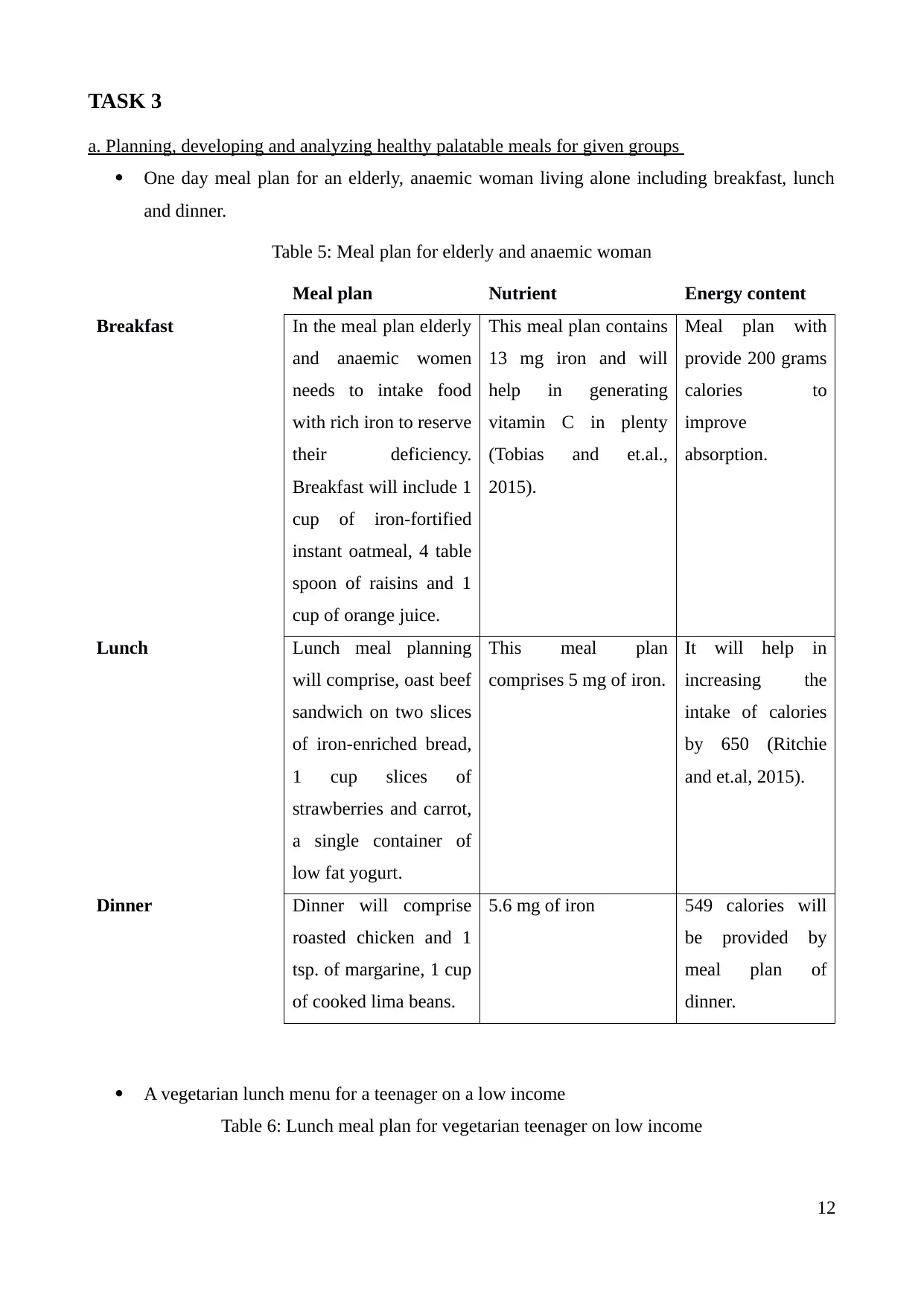
TASK 3
a. Planning, developing and analyzing healthy palatable meals for given groups
One day meal plan for an elderly, anaemic woman living alone including breakfast, lunch
and dinner.
Table 5: Meal plan for elderly and anaemic woman
Meal plan Nutrient Energy content
Breakfast In the meal plan elderly
and anaemic women
needs to intake food
with rich iron to reserve
their deficiency.
Breakfast will include 1
cup of iron-fortified
instant oatmeal, 4 table
spoon of raisins and 1
cup of orange juice.
This meal plan contains
13 mg iron and will
help in generating
vitamin C in plenty
(Tobias and et.al.,
2015).
Meal plan with
provide 200 grams
calories to
improve
absorption.
Lunch Lunch meal planning
will comprise, oast beef
sandwich on two slices
of iron-enriched bread,
1 cup slices of
strawberries and carrot,
a single container of
low fat yogurt.
This meal plan
comprises 5 mg of iron.
It will help in
increasing the
intake of calories
by 650 (Ritchie
and et.al, 2015).
Dinner Dinner will comprise
roasted chicken and 1
tsp. of margarine, 1 cup
of cooked lima beans.
5.6 mg of iron 549 calories will
be provided by
meal plan of
dinner.
A vegetarian lunch menu for a teenager on a low income
Table 6: Lunch meal plan for vegetarian teenager on low income
12
a. Planning, developing and analyzing healthy palatable meals for given groups
One day meal plan for an elderly, anaemic woman living alone including breakfast, lunch
and dinner.
Table 5: Meal plan for elderly and anaemic woman
Meal plan Nutrient Energy content
Breakfast In the meal plan elderly
and anaemic women
needs to intake food
with rich iron to reserve
their deficiency.
Breakfast will include 1
cup of iron-fortified
instant oatmeal, 4 table
spoon of raisins and 1
cup of orange juice.
This meal plan contains
13 mg iron and will
help in generating
vitamin C in plenty
(Tobias and et.al.,
2015).
Meal plan with
provide 200 grams
calories to
improve
absorption.
Lunch Lunch meal planning
will comprise, oast beef
sandwich on two slices
of iron-enriched bread,
1 cup slices of
strawberries and carrot,
a single container of
low fat yogurt.
This meal plan
comprises 5 mg of iron.
It will help in
increasing the
intake of calories
by 650 (Ritchie
and et.al, 2015).
Dinner Dinner will comprise
roasted chicken and 1
tsp. of margarine, 1 cup
of cooked lima beans.
5.6 mg of iron 549 calories will
be provided by
meal plan of
dinner.
A vegetarian lunch menu for a teenager on a low income
Table 6: Lunch meal plan for vegetarian teenager on low income
12
⊘ This is a preview!⊘
Do you want full access?
Subscribe today to unlock all pages.

Trusted by 1+ million students worldwide
1 out of 18
Related Documents
Your All-in-One AI-Powered Toolkit for Academic Success.
+13062052269
info@desklib.com
Available 24*7 on WhatsApp / Email
![[object Object]](/_next/static/media/star-bottom.7253800d.svg)
Unlock your academic potential
Copyright © 2020–2025 A2Z Services. All Rights Reserved. Developed and managed by ZUCOL.





